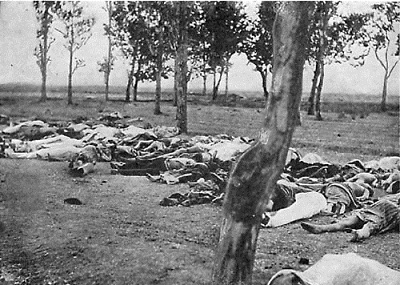|
|
|

What is the Armenian
Genocide?
The atrocities committed against the
Armenian people of the Ottoman
Empire during WWI are defined as the
Armenian Genocide.
Those massacres were perpetrated
throughout different regions of the
Ottoman Empire by the Young Turkish
Government which was in power at the
time.
The first international reaction to
the violence resulted in a joint
statement by France, Russia and
Great Britain, in May 1915, where
the Turkish atrocities directed
against the Armenian people was
defined as “new crime against
humanity and civilization” agreeing
that the Turkish government must be
punished for committing such crimes.
Why was the
Armenian Genocide perpetrated?
When WWI erupted, the Young Turk
government, hoping to save the
remains of the weakened Ottoman
Empire, adopted a policy of Pan
Turkism – the establishment of a
mega Turkish empire comprising of
all Turkic-speaking peoples of the
Caucasus and Central Asia extending
to China, intending also to Turkify
all ethnic minorities of the empire.
The Armenian population became the
main obstacle standing in the way of
the realization of this policy.
Although the decision for the
deportation of all Armenians from
the Western Armenia (Eastern Turkey)
was adopted in late 1911, the Young
Turks used WWI as a suitable
opportunity for its implementation.
How many people
died in the Armenian Genocide?
There were an estimated two million
Armenians living in the Ottoman
Empire on the eve of WWI.
Approximately one and a half million
Armenians perished between 1915 and
1923. Another half million found
shelter abroad.
The mechanism of
implementation
Genocide is the organized killing of
a people for the express purpose of
putting an end to their collective
existence. Because of its scope,
genocide requires central planning
and an internal machinery to
implement. This makes genocide the
quintessential state crime, as only
a government has the resources to
carry out such a scheme of
destruction.
On 24th of April in 1915, the first
phase of the Armenian massacres
began with the arrest and murder of
nearly hundreds intellectuals,
mainly from Constantinople, the
capital of Ottoman Empire (now
Istanbul in present day Turkey).
Subsequently, Armenians worldwide
commemorate the April 24th as a day
that memorializes all the victims of
the Armenian Genocide.
The second phase of the ‘final
solution’ appeared with the
conscription of some 60.000 Armenian
men into the general Turkish army,
who were later disarmed and killed
by their Turkish fellowmen.
The third phase of the genocide
comprised of massacres, deportations
and death marches made up of women,
children and the elderly into the
Syrian deserts. During those marches
hundreds of thousand were killed by
Turkish soldiers, gendarmes and
Kurdish mobs. Others died because of
famine, epidemic diseases and
exposure to the elements. Thousands
of women and children were raped.
Tens of thousands were forcibly
converted to Islam.
Finally, the fourth phase of the
Armenian genocide appeared with the
total and utter denial by the
Turkish government of the mass
killings and elimination of the
Armenian nation on its homeland.
Despite the ongoing international
recognition of the Armenian
genocide, Turkey has consistently
fought the acceptance of the
Armenian Genocide by any means,
including false scholarship,
propaganda campaigns, lobbying, etc.
Ի՞նչ
է
Հայոց
ցեղասպանությունը:
Օսմանյան
կայսրությունում
Առաջին
համաշխարհային
պատերազմի
տարիներին
իրագործված
հայ
բնակչության
կոտորածներն
անվանում
են
Հայոց
ցեղասպանություն:
Այդ
կոտորածներն
իրագործվեցին
երիտթուրքական
կառավարության
կողմից
Օսմանյան
կայսրության
տարբեր
շրջաններում:
Միջազգային
առաջին
արձագանքն
այս
իրադարձություններին
Ֆրանսիայի,
Ռուսաստանի,
Մեծ
Բրիտանիայի` 1915թ.
մայիսի
24
համատեղ
հայտարարությունն
էր,
որտեղ
հայ
ժողովրդի
նկատմամբ
կատարված
բռնությունները
բնորոշվեցին
որպես
«հանցագործություն
մարդկության
և
քաղաքակրթության
դեմ»:
Կողմերը
կատարված
հանցագործության
համար
պատասխանատու
էին
համարում
թուրքական
կառավարությանը:
Ինչու՞
իրագործվեց
Հայոց
ցեղասպանությունը:
Երբ
սկսվեց
Առաջին
համաշխարհային
պատերազմը,
երիտթուրքական
կառավարությունը,
ջանալով
պահպանել
թուլացած
Օսմանյան
կայսրության
մնացորդները,
որդեգրեց
պանթուրքիզմի
քաղաքականությունը,
այն
է,
հսկայածավալ
Թուրքական
կայսրության
ստեղծում,
որը,
տարածվելով
մինչև
Չինաստան,
իր
մեջ
կներառեր
Կովկասի,
Միջին
Ասիայի
բոլոր
թյուրքալեզու
ժողովուրդներին:
Ծրագիրը
նախատեսում
էր
բոլոր
ազգային
փոքրամասնությունների
թյուրքացում:
Հայ
բնակչությունը
դիտվում
էր
որպես
գլխավոր
խոչընդոտ
այս
ծրագրի
իրականացման
ճանապարհին:
Թեև
Հայոց
ցեղասպանությունը
ծրագրավորվել
էր
դեռևս 1911-1912
թթ.,
երիտթուրքերը
որպես
հարմար
առիթ
օգտագործեցին
Առաջին
համաշխարհային
պատերազմի
սկիզբը`
իրագործելով
այն:
Ինչքա՞ն
մարդ
զոհվեց
Հայոց
ցեղասպանության
ընթացքում:
Առաջին
համաշխարհային
պատերազմի
նախօրեին
Օսմանյան
կայսրությունում
ապրում
էին
երկու
միլիոնից
ավել
հայեր:
Շուրջ
մեկուկես
միլիոն
հայ
սպանվեց 1915-1923թթ.,
իսկ
մնացյալ
հատվածը
կամ
բռնի
կերպով
մահմեդականացվեց,
կամ
ապաստանեց
տարբեր
երկրներում:
Ցեղասպանության
իրագործման
մեխանիզմը:
Ցեղասպանությունը
մարդկանց
կազմակերպված
բնաջնջումն
է`
նրանց
կոլեկտիվ
գոյությանը
վերջ
դնելու
հիմնական
նպատակով:
Հետևաբար,
ցեղասպանության
իրագործման
համար
անհրաժեշտ
է
կենտրոնացված
ծրագրավորում
և
դրա
իրագործման
ներքին
մեխանիզմ,
ինչն
էլ
ցեղասպանությունը
դարձնում
է
պետական
հանցագործություն,
քանի
որ
միայն
պետությունն
է
օժտված
այն
բոլոր
ռեսուրսներով,
որոնք
կարելի
է
օգտագործել
այս
քաղաքականությունն
իրականացնելու
համար:
1915թ.
ապրիլի 24-ին
սկսած
ձերբակալությամբ
(հիմնականում
Օսմանյան
կայսրության
մայրաքաղաք
Կոստանդնուպոլսից)
և
դրան
հետևած
հարյուրավոր
հայ
մտավորականների
ոչնչացմամբ,
սկսվեց
հայ
բնակչության
բնաջնջման
առաջին
փուլը:
Հետագայում
աշխարհասփյուռ
հայերը
ապրիլի
24-ը
սկսեցին
նշել
որպես
Հայոց
ցեղասպանության
զոհերի
հիշատակի
օր:
Հայոց
ցեղասպանության
իրագործման
երկրորդ
փուլը`
մոտ 60.000
հայ
տղամարդկանց
զորակոչն
էր
թուրքական
բանակ,
որոնք
ավելի
ուշ
զինաթափվեցին
ու
սպանվեցին
իրենց
թուրք
զինակիցների
կողմից:
Ցեղասպանության
երրորդ
փուլը
նշանավորվեց
կանանց,
երեխաների,
ծերերի
ջարդով,
տեղահանությամբ
դեպի
սիրիական
անապատ:
Տեղահանության
ընթացքում
հարյուր
հազարավոր
մարդիկ
սպանվեցին
թուրք
զինվորների,
ոստիկանների,
քրդական
ավազակախմբերի
կողմից,
մյուսները
մահացան
սովից,
համաճարակային
հիվանդություններից:
Հազարավոր
կանայք
ու
երեխաներ
ենթարկվեցին
բռնության:
Տասնյակ
հազարավոր
մարդիկ
բռնի
մահմեդականացվեցին:
Վերջապես,
Հայոց
ցեղասպանության
վերջին
փուլը`
թուրքական
կառավարության
մասսայական
տեղահանությունների
և
հայ
ազգի
դեմ
իր
իսկ
հայրենիքում
իրագործված
բնաջնջման
համընդհանուր
և
բացարձակ
ժխտումն
է:
Չնայած
Հայոց
ցեղասպանության
միջազգային
ճանաչման
շարունակվող
գործընթացին`
Թուրքիան
շարունակում
է
ամեն
կերպ
պայքարել
Հայոց
ցեղասպանության
ճանաչման
դեմ,
այդ
թվում`
պատմության
նենգափոխում,
քարոզչական
միջոցներ,
լոբբի
և
այլն:
|